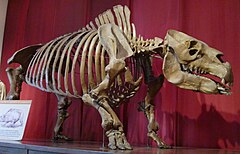
Back توكسودون Arabic Токсодони Bulgarian Toxodon Catalan Toxodon Czech Toxodon German Toxodon Spanish کماندندان Persian Toxodon Finnish Toxodon French טוקסודון HE
| Toxodon | |
|---|---|

| |
| Skeleton of Toxodon in Buenos Aires | |
| Scientific classification | |
| Domain: | Eukaryota |
| Kingdom: | Animalia |
| Phylum: | Chordata |
| Class: | Mammalia |
| Order: | †Notoungulata |
| Family: | †Toxodontidae |
| Subfamily: | †Toxodontinae |
| Genus: | †Toxodon Owen, 1837 |
| Type species | |
| †Toxodon platensis Owen, 1837
| |
| Other species | |
| |
| Synonyms | |
|
Genus-level
T. platensis
T. burmeisteri
T. chapalmalensis
T. ensenadensis
T. gracilis
| |
Toxodon (meaning "bow tooth" in reference to the curvature of the teeth) is an extinct genus of large ungulate native to South America from the Late Miocene to early Holocene epochs (Mayoan to Lujanian in the SALMA classification) (about 11.6 million to 11,000 years ago).[1][2] Toxodon is a member of Notoungulata, an order of extinct South American native ungulates distinct from the two living ungulate orders that had been indigenous to the continent for over 60 million years since the early Cenozoic, prior to the arrival of living ungulates into South America around 2.5 million years ago during the Great American Interchange.[3] Toxodon is a member of the family Toxodontidae, which includes medium to large sized herbivores.[4] Toxodon was one of the largest members of Toxodontidae and Notoungulata, with Toxodon platensis having an estimated body mass of 1,000–1,200 kilograms (2,200–2,600 lb).[5]
Toxodon has been found across much of South America, excluding southern Patagonia, the Andes and northeastern-most region of the continent.[6] Evidence suggests that Toxodon was ecologically plastic and able to adapt its diet to local conditions.[7]
Toxodon became extinct as part of the end-Pleistocene extinctions around 12,000 years ago, along with most large mammals across the Americas.[3]
- ^ Baffa O, Brunetti A, Karmann I, Neto CM (May 2000). "ESR dating of a toxodon tooth from a Brazilian karstic cave". Applied Radiation and Isotopes. 52 (5): 1345–9. Bibcode:2000AppRI..52.1345B. doi:10.1016/S0969-8043(00)00093-2. PMID 10836452.
- ^ Turvey ST (28 May 2009). Holocene Extinctions. OUP Oxford. ISBN 978-0-19-157998-1.
- ^ a b Cite error: The named reference
:2was invoked but never defined (see the help page). - ^ Cassini, Guillermo H.; Flores, David A.; Vizcaíno, Sergio F. (July 2012). "Postnatal ontogenetic scaling of Nesodontine (Notoungulata, Toxodontidae) cranial morphology: Nesodontine cranial allometry". Acta Zoologica. 93 (3): 249–259. doi:10.1111/j.1463-6395.2011.00501.x. hdl:11336/81335.
- ^ Nelson, Allison; Engelman, Russell K.; Croft, Darin A. (12 July 2023). "How to weigh a fossil mammal? South American notoungulates as a case study for estimating body mass in extinct clades". Journal of Mammalian Evolution. 30 (3): 773–809. doi:10.1007/s10914-023-09669-1. ISSN 1064-7554. S2CID 259866522.
- ^ Cione, Alberto Luis; Gasparini, Germán Mariano; Soibelzon, Esteban; Soibelzon, Leopoldo Héctor; Tonni, Eduardo Pedro (2015), "The GABI in Southern South America", The Great American Biotic Interchange, Dordrecht: Springer Netherlands, pp. 71–96, doi:10.1007/978-94-017-9792-4_3, ISBN 978-94-017-9791-7, S2CID 127856682, retrieved 30 January 2024
- ^ Cite error: The named reference
:3was invoked but never defined (see the help page).
© MMXXIII Rich X Search. We shall prevail. All rights reserved. Rich X Search